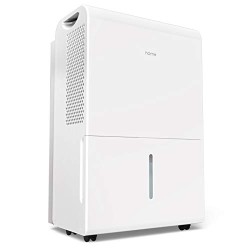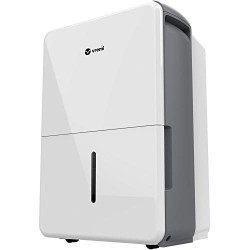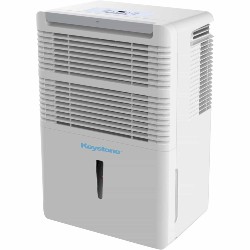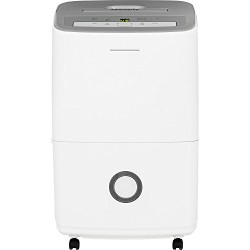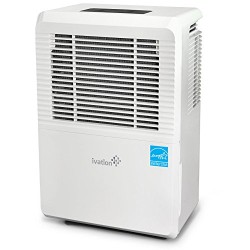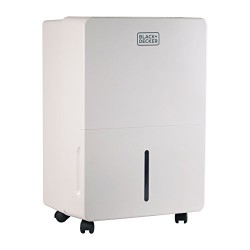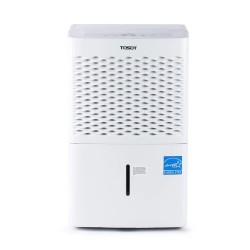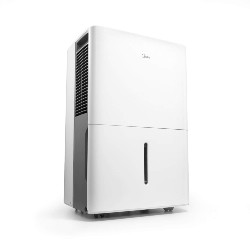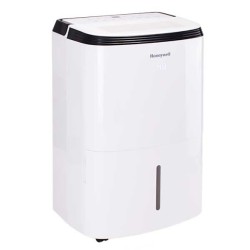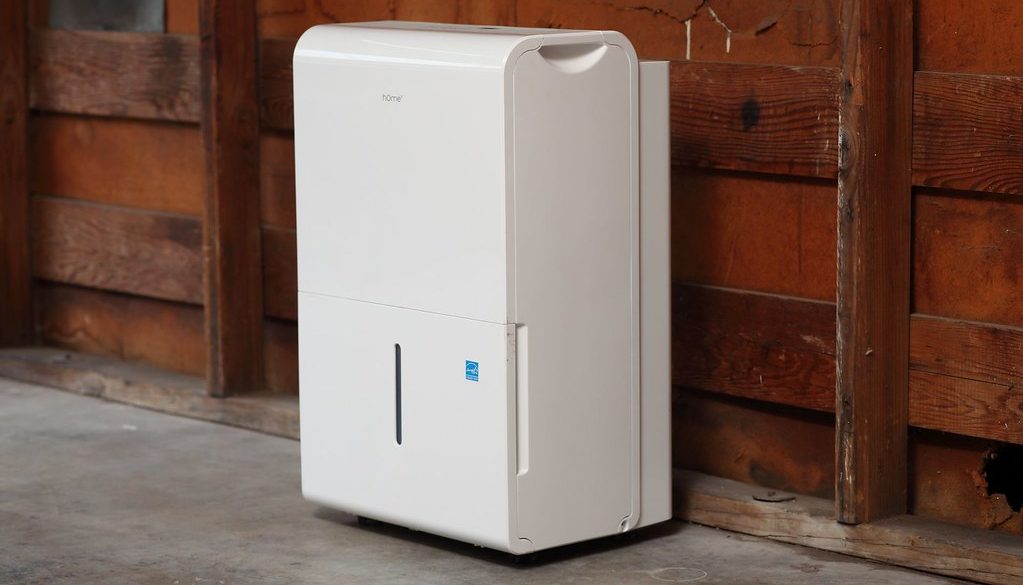We tested dozens of the best 70 pint dehumidifiers to see which ones were worth purchasing. Below are the results of hours of testing combined with extensive research to see what others who’ve used each product were saying. Some of the things we looked at were the water tank capacity, rate of dehumidification, coverage area, and energy consumption rate.
10 Best 70 Pint Dehumidifiers in 2020
Frigidaire High 70 Pints
This Frigidaire 70 pint dehumidifier is for large spaces that have significant issues with moisture in the air.
During our testing and research, the Frigidaire 70 Pint dehumidifier stood out for the minor details designed to make using it easy and convenient.
Some of these features include the easy access water bucket, caster wheels, and handle for easier mobility, electronic controls, and digital readout.
The tank holds up to 2 gallons and has an automatic shut off feature as well as an alarm when it fills up.
To avoid needing to empty the tank regularly, there is an automatic self-draining feature. You will need to attach a standard garden hose to the dehumidifier and adjust the settings.
PROS
- Continuous use through self-draining
- Auto shutoff and full tank alert
- Energy Star Certified 70 pint dehumidifier
- 6-foot power cord for greater reach
CONS
- Control panel display could be brighter
Homelabs 4500
Homelabs designed the 4500 model to be residential friendly. Out of all the units we tested, this was one of the quietest.
The design is sleek, and the buttons on the electronic panel are simple with easy to read and understand labels.
The water tank holds up to 1.8 gallons of water and has a drain port in the back allowing you to attach a continuous drain hose.
There is no built-in pump to force water out, and some users noted the reservoir has trouble draining if the tube is not angled downwards.
One of the main selling points is that you can set the unit to work continually. On the other hand, you can set it to a desired dampness level, which will turn the dehumidifier off and on to keep the room at your setting.
PROS
- Cleans up to 4,500 square feet space
- Easy to use electronic controls
- Turbo setting to remove moisture from the air
- Quieter than other units we reviewed
CONS
- Lacks a built-in pump
- Shorter warranty than some other brands
Vremi 4500
The Vremi 4500 stood out to us instantly for its Energy Star Certification.
You can run this continually throughout the day without worrying about excessive energy bills. There is no built-in pump on this unit, which is one downside.
However, it does offer a self drain option so you can leave it running without needing to check the reservoir levels frequently.
As with the Homlabs 4500, the user interface is simple. There are eight buttons, all clearly labeled to avoid confusion.
The model has different settings, filter mode, continuous dehumidification, turbo fan speed mode, and a timer setting. The multiple settings give you the ability to set it and forget it at a specific humidity level or run it on turbo mode for heavy-duty moisture removal.
Many users claimed they enjoyed how easy the unit was to move. The dehumidifier has caster wheels and handles that make it a more portable dehumidifier. The total weight for the unit without water is 41.6lbs. You can remove the dust filter, which makes regular maintenance for the machine much more straightforward.
PROS
- Slim profile for more placement options
- Multiple modes for different user needs
- Filters out dirt and common allergens
- Easy to use eight-button interface
CONS
- Louder than similar models
- Water container is tough to put back in
Keystone High Efficiency
The Keystone High Efficiency is simple and easy to use. A local physician recommended this unit, and we found it to be one of the best for convenience and ease of maintenance.
The filter is top loading and can be removed without any tools or needing to open the unit up. Many users reported they liked that the filter has a sensor that alerts you when it needs cleaning.
The tank can hold up to 1.6 gallons of water, smaller than other best 70 pint dehumidifier units we tested.
There is a handle on the tank, so if you opt to empty the reservoir manually, you can avoid spillage. There is a self drain option you can use by connecting a garden house to it. One downside is that the drainage hose is not included, but that is not uncommon with 70 pint dehumidifiers.
PROS
- Easy to maintain filter
- Auto shutoff when full
- Auto-defrost to keep from freezing
- Auto-restart saves previous settings
CONS
- User manual can be difficult to follow
- Lacks a built-in pump
Frigidaire FFAD7033R1
The first thing we noticed when testing the Frigidaire FFAD7033R1 is that it has a slim profile with all parts well placed.
On many of the other 70 pint dehumidifiers, the self drain nozzle sticks out and the handle at the top as well.
With this model, everything slides in and covers so that it displays as a solid and slim package.
As with a few of the best 70 pint dehumidifiers, this is an Energy Star certified unit.
It operates at a low temperature of 41 degrees, which lowers energy consumption and translates into savings on your energy bill. The water reservoir for the Frigidaire FFAD7033R1 holds 1.63 gallons.
To avoid having to empty the tank multiple times each day manually, it is best to use the self drain option. Like the other models on this list, you will need an average-sized garden house. The model doesn’t have a pump, so it relies on gravity for draining.
PROS
- Five-year sealed system warranty
- Frigidaire FFAD7033R1 is Star Rated
- Digital humidity readout and easy touch interface
- 24-hour timer with set and forget operation
CONS
- May be too loud for a bedroom
- Frigidaire FFAD7033R1 Lacks a built-in pump
Ivation Energy Star
We like to see star ratings when we review and test appliances to help you save on electric bills.
The Ivation 70 Pint meets all the criteria, and we found it to be one of the best dehumidifiers for energy efficiency.
The Ivation 70 Pint Energy Star has other power-saving features, including auto-shutoff and a sleep timer, to limit use.
The digital interface is easy to understand with one-touch buttons designed to be intuitive and easy to read.
You can choose from a few different settings using the filter mode, continuous mode, turbo mode, and auto defrost. There is also an auto-restart which remembers your exact settings. There are a few downsides we found during testing and research.
For one, the water reservoir is only 1.3 gallons, which is less than many of the other products on this list. If you aren’t using the self drain mode, you may find yourself emptying the container more frequently in heavy use situations. This unit also lacks a built-in pump for efficient drainage.
Another downside is that maintenance for this unit takes a bit more effort than others. To clean the filter, you need to first empty and remove the water reservoir. The drain hose is a clear plastic tube, so during testing, we found it more challenging to clean. You may need to get a pipe cleaner or other small brush to clean the port.
PROS
- Energy-star certified dehumidifier
- Turbo fan speed removes substantial moisture
- Frost sensor and auto-defrost
- Extra bright LCD
CONS
- Smaller water reservoir than other dehumidifiers
- Not as easy to clean as some units
Black + Decker BDT70
The Black + Decker BDT70 is one of the best models in terms of portability. The slim design is made to fit easily in any room of your house.
It’s on the heavier end at 48 lbs, but you can easily move it around using the wheels or carrying handle.
One of the best things about this unit is that it has a pump for pushing water out through the draining tube.
If you need to run your drainage to an elevated point, such as to a sink, this may be the best model.
The reservoir holds over two gallons making it the best on our list for the tank size. If you don’t plan to run the pump and instead will be emptying the canister manually, that’s a plus. The model has an easy to use electronic interface loaded with plenty of settings. It has preset levels based on the room of the house you will be using it in.
PROS
- Two-gallon water receiver
- Internal pump to push out water
- Best unit in terms of options
- Five-year compressor warranty
CONS
- Pump doesn’t work with memory feature
TOSOT 4500
This is a sleek and intuitive dehumidifier that we enjoyed testing. The user interface is easy to see, which is nice as many of the other models we researched and tested were non-intuitive.
It has light-touch intelligent electronic controls that are well labeled to avoid confusion. One other thing we noticed about the control panel is the numbers are bright.
Many of the units we saw had dim green numbers making them difficult to read, not the case with the TOSOT 4500. As with many of the other 70 pint dehumidifiers on this list, the TOSOT 4500 is a Star Certified product.
So you can cut down on power consumption even when set to continuous use. This dehumidifier uses whisper technology to reduce output noise.
On its highest setting, the noise level clocked in at 52 dB and 48 dB on the lowest setting. This is the equivalent of light rain at the lowest setting and a quiet indoor conversation on turbo fan speed mode.
The one downside that we noticed during testing is that the bucket fills up quickly. If you are using this in an area or basement that accumulates high moisture levels, we recommend using the gravity drain continuous flow option. If you opt to empty the water container manually, you may end up having to empty it three or more times each day.
PROS
- Star Certified dehumidifier
- Whisper technology operates quietly
- Auto-restart if power goes out
- Automatic shutoff when full
CONS
- Lacks a built-in pump
- Must remove tank to clean filter
MIDEA MAD50C1ZWS
The MIDEA MAD50C is one of the lightest and most portable dehumidifier units on this list. The out of box weight is 33lbs which makes it almost 20lbs lighter than the heaviest unit we tested.
If you plan on using this in a basement or moving it around the house, frequently the sturdy wheels and lighter weight make it easier to move.
The water reservoir holds 1.6 gallons putting it in the middle range for all of the 70 pint dehumidifiers we tested.
If you are using this in an area with high moisture levels, you will be emptying the bucket more than once per day. We recommend using the drain port, if possible. You will need to connect the female end of a garden house to set this up.
The self drain works off gravity as there is no built-in pump, so it will need to be in a higher place to drain efficiently. There is a convenient digital readout with one-touch buttons on the topside. During our research, we noticed some user complaints that the readout was challenging to see as it’s green against a dark grey background.
PROS
- Continual operation with self drain port
- 51 maximum decibel volume
- Remembers previous settings to set and forget
- Filter cleaning auto alert
CONS
- Warranty is only one year
- Digital display may be hard to read
Honeywell TP70KWN
The first thing we noticed when testing this dehumidifier was the multiple LED display panels that show the current humidity levels.
There is a display on the front and on the top where the settings panel is located. The front screen is exceptionally bright, making it easy to see from across the room.
Honeywell has designed the TP 70 for easy maintenance and upkeep. The filter is on the back of the unit and removes for cleaning without having to take apart anything else
It also has a large, heavy-duty handle which the manufacturer claims can withstand over 100lbs. You can quickly move the unit without having to empty the water tank if need be.
The total capacity for the reservoir is 1.75 gallons, so if you plan on running this continuously, you need to connect the self drain. If not, you will be emptying the unit multiple times each day, depending on moisture levels. Unlike many of the other dehumidifiers we tested, Honeywell has included a draining tube with the unit.
PROS
- 5-year manufacturer warranty
- Multi-display humidity reading
- Included self drain tube
- Top-rated Energy Star dehumidifier
CONS
- Higher noise level during testing
- Lacks a built-in pump
70 Pint Dehumidifier Buyers Guide
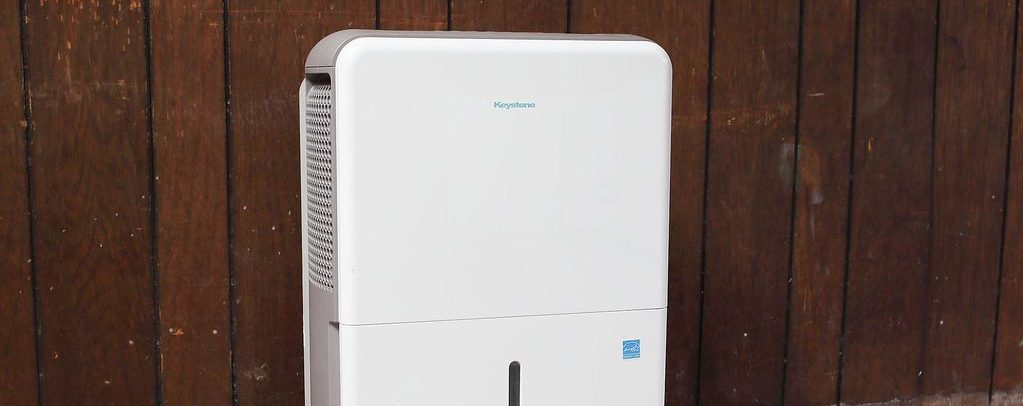
Dehumidifier Coverage Area
The coverage area for a dehumidifier is based on how many cubic feet or cubic meters can be adequately covered. Cubic measurements are used to measure the volume of a room accurately. Almost all of the 70 pint dehumidifiers we tested covered an area of up to 4500 cubic feet.
You must know how large the area you want covered is before committing to a dehumidifier. If you go too small, the unit will be unable to remove all of the moisture from the room effectively. It is better to get a dehumidifier that covers a larger area that you need than to get one that is too small for the place you want to use it in.
“...cubic measurements take all three dimensions into consideration. This will tell you the volume of a given area…”
- Paul Bianchina, Contractor/Author [1]
To calculate the volume of the room where you will use your dehumidifier, you can use the formula length x width x height. Compare the number you come up with to the coverage area listed on the dehumidifier to make sure you are getting the right choice for your needs.
70 Pint Built-In Pump
There are multiple ways that dehumidifiers can drain water. Traditionally, smaller units will need to be emptied manually and lack any sort of drainage port. On the larger end, 70 pint units come with a drainage port that allows them to operate without the need to empty when the tank is full.
In cheaper models, these drainage ports use gravity to force the water down and out a tube, usually a garden house. With dehumidifiers used in high moisture environments, this is sometimes not enough, and a built-in pump is used to force the water out continually.
The built-in pump allows for water to be pushed out vertically so that the dehumidifier can be placed lower than the drain. It also ensures that there are no disruptions in draining so that the reservoir doesn’t fill up, and the auto-shutoff doesn’t activate, causing delays in moisture removal.
Water Tank Capacity
The water tank capacity will determine how much excess moisture can be pulled from the air before the unit shuts off and needs to be emptied. The water reservoir is usually measured in pints or gallons on a 70 pint dehumidifier. Smaller units will measure water tank capacity by ounces.
Dehumidifiers used with a self drain hose will bypass the water tank making the capacity less important. But, if you can’t use the drain tube because the unit doesn’t have a pump, the size becomes more important. Basically, the larger the water tank, the less frequently you will need to empty it.
Larger water containers will also allow the dehumidifier to pull excess moisture from the air as it can run longer. The more frequently your dehumidifier shuts off due to the reservoir being full, the less it will be able to pump moisture from the air. Of all the 70 pint dehumidifier units we researched, the average water tank capacity was between 1 and 2 gallons.
Rate of Dehumidification
This number will dictate how much moisture can be pulled from the air in every given time frame. Usually, this is measured in pint. So, for a 70 pint humidifier, you can remove up to 70 pints of moisture per day if the unit is operating in continuous mode.
Just because a dehumidifier can pull a certain amount of moisture from the air each day doesn’t mean it will. Some factors that can impact the rate of dehumidification include having to empty the tank, colder environments where the unit has to defrost, and other factors [2]
The easiest way to calculate the rate you need is by using an external hygrometer. This device will allow you to get a reading of the humidity levels in a room [3]. You can use this reading to understand better how humid the room gets and how much you need a dehumidifier to remove daily.
“The ideal [humidity range] is somewhere around 45-55%. Very high levels of humidity contribute to the growth of mold, funguses, dust mites, and other pests.”
- Erik Hinrichsen, Mechanical Engineer [4]
Energy Consumption Rate
Energy consumption rate, also known as the power consumption rate, is a measurement of how much power an appliance uses during regular operation. This number will determine how much it costs you to use your dehumidifier. This is usually measured by how many watts every device uses in one hour, also known as a kilowatt.
In an ideal world, all of your appliances would be energy efficient and save you money each month. In reality, many household appliances are not energy efficient and can significantly increase your electric bills. Dehumidifiers can easily fall into this category if they are being operated continuously throughout the day.
It’s essential to look for an Energy Star rated or certified dehumidifier. Energy Star rated products are designed to decrease energy consumption so that appliances are both greener and cost-effective [5].
Continuous Drain Option
Larger dehumidifiers, such as 70 pint models, have a drainage port located on the back or side to attach a garden hose. This hose is gravity fed and allows water to bypass the tank and drain directly. The reason for this is so that the dehumidifier can operate continuously without having to shut down for you to empty the water tank manually.
If you need a dehumidifier for heavy moisture removal, such as after flooding or during extreme dampness, this feature is essential. To make using the drain option even more efficient, it's best to have a unit with a pump. The pump allows you to run a hose vertically.
Size and Weight
The size and weight of a dehumidifier will determine how easy it is for you to move and place it. Before deciding how large a humidifier you need, think about where you are going to use it.
Will this be going in a basement or upstairs area? If so, a lighter weight unit will be ideal for making it easier to move up and down. Will you be using this in a living room or other room in full view? You want a slim design easier to place in a corner or under a table out of the way.
During our research of 70 pint dehumidifiers, we found the average eight to be around 30lbs on the lighter end and up to 55lbs for the heaviest units. The average unit weight was around 40lbs. There were no standard dimensions for units, with some being shorter and wider in the frame and others being a few inches taller.
70 Pint Extra Features
There are several additional features that you want to look out for when purchasing a 70 pint dehumidifier. This ranges from comfort settings to safety features, which make using the unit easier and more reliable. One of the best of these extra features is a defrosting option.
When the weather gets too cold, it can cause the water moving through the dehumidifier to turn into ice. This can damage the dehumidifier and may even break it. Look for dehumidifiers that have an auto-defrost option, which will kick in when any ice build-up is detected.
Another helpful feature to look out for is switching between continuous flow and a timer setting or dampness level preset. Constant flow means that the dehumidifier will run all-day without stopping.
Timed settings allow you to have the unit shut off at certain times, similar to a sleep timer on your television. The last option, a humidity preset, lets you set the device based on personal preference.
There are a few safety features you want to pay attention to as well. Always ensure that any dehumidifier you buy has an auto-shutoff if the tank fills up. If you are running it while you are not home, you don’t want the water to spill out of the tank and cause further water damage. An auto-shutoff has a sensor in the reservoir which tells the unit when it is getting too full.
Air filter cleaning sensors are also helpful. This detects when it is time for you to clean the air filter and will let you know. Usually, there will be an LED display light on the panel that lets you know it’s time. Not all dehumidifiers have this feature, so you have to look out for it in the description.
How to Measure Pint Capacity
To measure the right pint capacity for your dehumidifier, you need first to understand how much moisture needs to be removed and how large the space or basement is.
“Dehumidifier capacity is usually measured in pints per 24 hours and is determined by two factors: the size of the space that needs to be dehumidified and the conditions that exist in the space before dehumidification.”
- US Department of Energy [6]
Testing conditions for dehumidifiers are 65 degrees Fahrenheit at 60% humidity [7]. If the area or basement you will be using it in is at or around these conditions, then you can use the standard square footage rating. These are:
Slightly Damp
50% to 60% Humidity
- 300 square feet = 30 pints of moisture
- 500 square feet = 40 to 45 pints of moisture
- 800 square feet = 60 pints of moisture
- 1,200 square feet+ = 70 pints of moisture
For a frame of reference, a slightly damp area or basement is considered to have a somewhat heavy feeling in the air. For moderately damp environments, around 60% to 70% humidity, the pint levels stay the same. Moderately humid environments are considered to have a slightly musty smell.
Very damp environments, humidity levels between 70% and 80%, will need an extra 5 to 10 pints added to each square foot measurement. This is considered to be when the walls and floors have wet spots.
Wet environments, when the dampness levels are between 80% and 100%, will need an extra 10 to 20 pints added to each square footage level beyond the slightly damp measurements. Wet environments are those where there is seepage on the walls and floor and potential mold and mildew build-up.
FAQs
The optimal humidity range for a home is between 40% and 50%. This has been set by various governmental bodies based on studies connecting regular exposure to high humidity with adverse health conditions. The upper limit for acceptable humidity levels is 60% to 80% [5]
A 70 pint dehumidifier will cover, on average, 4500 square feet. Other factors that can impact this number are how many cubic feet the room is and how high moisture levels are. Larger rooms with high moisture levels may put more strain on a dehumidifier.
How frequently you have to empty the dehumidifier depends on how much moisture is sucked from the air. In a wet environment, you may need to empty the unit every 3 to 5 hours. In a slightly moist environment, you may not need to empty the reservoir for over a day.
Using the drain port with a hose will let you avoid having to empty the tank. This will drain the water automatically by bypassing the water reservoir completely.
You can leave the dehumidifier running continuously as long as it has an auto-shutoff feature when the tank gets too full. You do not want the container to overfill and water to spill out into the dehumidifiers electrical components or back onto the floor.
It is helpful to use the self-draining function as well if you want to run your unit continuously. This will altogether bypass the tank and allow the water to drain as it is sucked in.
If you forget to empty the dehumidifier on time, the auto-shutoff feature will kick in and turn the unit off. This feature uses a floating device in the water tank to measure how full it’s getting. Whenever the device reaches a certain threshold, the auto-shutoff kicks in and turns off the dehumidifier.
During our research, we found this to be a standard feature in all the best 70 pint dehumidifier models. But, it is essential to make sure that the model you use has this function and that it is working correctly.
Here's the Best 70 Pint Dehumidifier
Out of many models we reviewed, the Frigidaire High 70 proved to be the best 70 pint dehumidifier. The unit has all of the best features you need, including an auto-drain port, intuitive settings interface, bright LED readout, an auto-shutoff, and more.
The Energy Star certification goes a long way as a mark of efficiency through less power consumption. We were also particularly impressed by the sleek design and slim profile. The level of detail that made this model convenient and easy to use help it stand out as the best 70 pint dehumidifier on our list.
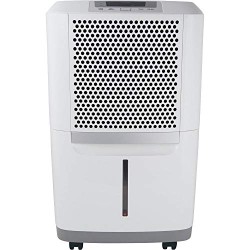
Frigidaire High 70 Pints
Our #1 Recommendation
- Continuous use through self-draining
- Auto shutoff and full tank alert
- Energy Star Certified 70 pint dehumidifier
- 6-foot power cord for greater reach

